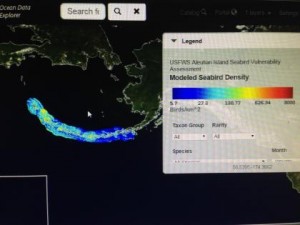A local scientist and entrepreneur is leadinga mapping project to find out where potential oil spills could have the worst effects on seabirds.
Martin Renner owns Turnagain Consulting based in Homer and has a background in biology. A little more than two years ago, Fish and Wildlife Service got a grant and contracted Renner.
“The motivation was fairly specific, for oil spills affecting birds in the Aleutian Islands.”

His job was to collect and collate data on bird population density and shipping traffic in the Aleutians and find out where they overlap the most.
“And you could interpret it both for the risk of a large catastrophic oil spill or for the risk of chronic oil pollution that is just the byproduct of any kind of industrial shipping activity.”
Basically, if there are a lot of ships traveling through a single area, that raises the likelihood of a spill there. That’s particularly dangerous if, say, there’s a large summer nesting population of seabirds in the same spot.
“The main choke point is in Unimak Pass near Dutch Harbor. We already knew that there are high densities of seabirds both in summer and in winter and every vessel that travels through the Bering Sea between east to west really needs to go through this one pass.”
That was something he expected to find. Something he didn’t expect was a buildup of vessels and birds just south of Sand Point near the shelf break, for example.
“Well, the data all existed before, but there was no analysis to really put it together. There was no model to show you what kind of seabird densities to expect in different places.”
Renner says he did some of the data collection, but most of it came from observations going back decades. The bird data is based on at-ship surveys with observers on research and container vessels. They counted birds 10 minutes at a time and used GPS to mark their locations.
For the ship data, Renner says they were interested in large ocean-going ships like container vessels that carry a lot of fuel and could cause a large spill. Many of those ships have automated equipment that radios in their position with a weather report, for example.
He developed a mapping tool that put those two virtual maps on top of each other. The new map will inform oil spill mitigation efforts.
“There are now plans to put more response gear into the Aleutians, like into Dutch Harbor, like offshore tugboats. By having more data on where those critical areas are, it will allow us to make more informed decisions on strategically placing those resources.”
His map not only found new choke points, it showed that some old ideas on good places to put equipment and response gear weren’t that useful. For example, there had been plans to possibly station a tug in Adak.
“It’s fairly clear that Adak would not be an ideal spot. It’s far away from concentrations of shipping traffic and it’s also not really at the heart of the main seabird densities. You’d have to travel several days from Adak to get to a likely position, whereas at Sand Point, you’d be within an hour’s striking distance.”
Renner says this project is just one piece of a larger ongoing effort to utilize current technology to process information from the past and hopefully, better protect vulnerable species in an environment that’s getting busier and more industrialized every day.




